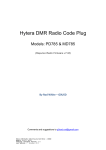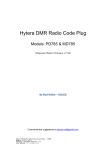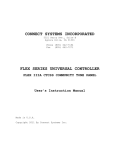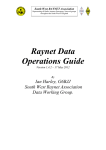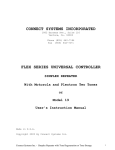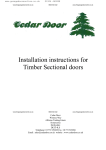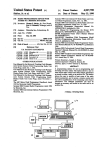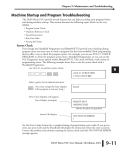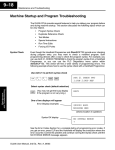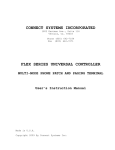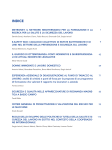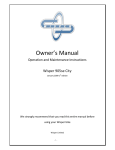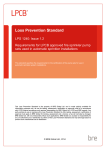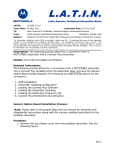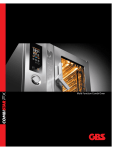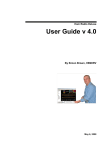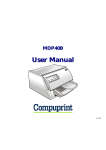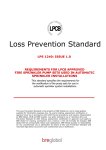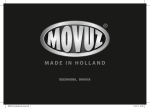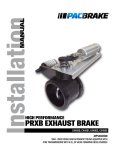Download CS-700 & CS-701 Review-1
Transcript
Review Peter Howard G0AFN, e-mail: [email protected] Connect Systems CS-700 and CS-701 DMR Handhelds Peter Howard G0AFN reviews two handheld transceivers designed to work with the increasingly popular Digital Mobile Radio (DMR) standard for digital voice. Digital Mobile Radio (DMR) is based on an open standard that was developed by members of the European Telecommunication Standards Institute (ETSI) for digital voice transmission in the private mobile radio (PMR) service and it is supported by most major manufacturers of PMR equipment. Further details can be found on the internet, for example on Wikipedia, and I understand PW will have more on digital voice in the coming months. From our point of view as radio amateurs, the DMR technology is now finding its way into amateur radio service, partly as a result of PMR equipment based on the DMR standard coming available on the surplus market. DMR is relatively well established in the US, where there is a good network of repeaters on the 2m and 70cm bands. There are now DMR repeaters covering much of the UK too. I have no means of making detailed technical measurements so I start with the assumption that the radios meet their published specification. The CS701 is rated at 5W output while the CS700 produces 4W out. The handbook supplied with the radios gives the user more technical data and further information is available on the internet, for example, on the Taylor Made RF website or from Connect Systems own website. www.tmrf.co.uk www.connectsystems.com What I was able to do, as a current user of DMR, was to use my existing equipment and my experience as a DMR user as a benchmark for the reviews of the two sets. I have therefore based this review on my personal evaluation and on the reports that I have received from others in respect of both the performance of the radios and how they live up to everyday practical use. The CS-700 and CS-701 I have been a DMR user for some time and was delighted to be asked to conduct a hands-on review of the CS-701 VHF (2m) version and the CS-700 for UHF (70cms). Both transceivers have an analogue (FM) and digital (DMR) mode and feature a two-line LCD display. These radios are manufactured by Connect Systems of California and are now available here in the UK. The radios I tested were kindly loaned by Taylor Made RF of Borehamwood. A Little About DMR For those not familiar with DMR, some background might be helpful. I should start by making it clear that the various digital voice modes currently in amateur use do not interwork. The DMR network uses the Motorola TRBO standards and protocols for interconnection while other digital networks will have their own systems. DMR is able to support voice, data and a range of other features and applications in both conventional and trunking mode. The digital repeaters 14 Practical Wireless, October 2014 currently being installed for amateur radio purposes take advantage of the time division multiple access (TDMA) technology of DMR to allow for either two simultaneous voice channels or one voice and one data channel. The total bandwidth taken by a DMR signal is 12.5kHz and the two channels within that bandwidth are designated Slots 1 and 2. The network of DMR repeaters is growing all the time and if you are in range of one of them, you have the potential for worldwide QSOs because the various repeaters are being networked so that DMR users can link through to any other DMR user worldwide. The website below has the latest information about the coverage of the international DMR network. www.dmr-marc.net www.trbo.org The networking aspect of DMR is key. If all you want to do is to chat across town, DMR probably isn’t for you because the technology really comes into its own when you have access to a DMR repeater. The good news is that the DMR network in the UK is expanding rapidly, with several licence applications currently in the pipeline at Ofcom. Most DMR repeaters are set up and paid for by a repeater keeper, which is why the locations for DMR repeaters may not be the best – commercial sites are simply too expensive. Despite this, you will probably be able to access one either now or in the near future although if your nearest repeater is some distance away, you may need an external antenna rather than being able to rely on the small antenna on a typical handheld. Right now in the UK, most digital repeater activity is on the 70cm band but some 2m repeaters are being installed. However, there should be no need to own radios for both bands – the whole benefit of this digital technology is that the nodes are networked. As long as you can access your local repeater, you can work through to a user on any other repeater, whichever band it is on. Incidentally, many repeater keepers also provide unpaid support by supplying up to date and ongoing codeplugs. The codeplug is the programming that is installed in your radio or the repeater. When I saw a codeplug for the first time I thought, “Blimey, I’m glad I didn’t have to do that to get on air”. However, the time inevitably comes when you delve into your radio’s software to meet your particular needs and then you can Practical Wireless, October 2014 see what has gone into making a DMR radio and repeater, especially where the repeater has been added to the DMR-MARC worldwide network. We owe these repeater keepers an enormous debt of gratitude for keeping the network going. This is probably also a good moment to mention that to take full advantage of the network’s capabilities, including keeping track of where you are at any given time (akin to the roaming facilities that you are familiar with on your mobile phone), you need to register on the DMR network. When you register, you will be assigned a user ID that you then program into your transceiver. After that, you can connect to any DMR repeater and not only will you be able to make QSOs worldwide but other users will be able to find and call you. Buying a DMR Radio If you are in the market for a DMR radio, the competitive choices at this time are limited. Radios sold primarily for commercial use are expensive when new and even when secondhand. They may also be limited in their software options. Unless you know what you are doing or have access to someone who does, such a set will probably end up in your shack as no more than an expensive doorstop. The nature of DMR means that there is a lot of initial setting up to do and you usually can’t just take the radio out of the box, charge the battery and get started. However, you don’t need to worry about this because your dealer will almost certainly be happy to do the initial setup for you, as Taylor Made RF do for purchasers of their radios. In fact, they have gone a step further by including their own ‘Ten Easy Program Steps’ guide to get you started in the DMR world. They also make free software updates to the codeplugs available from their online store. Even if you opt to have your radio pre-programmed by the dealer, there will be a learning curve. For example, on powering up your set you will be greeted by the new language of the DMR radio world. The read-out on the radio’s display will have acronyms like TG235 S2, UK Wide S1 and TG8 S2. Don’t panic because you will soon get the hang of it all and be in a position to benefit from facilities such as data transmission and worldwide networking that traditional FM repeaters simply don’t offer. It’s these facilities that make DMR and similar systems so attractive and explain why so many amateurs are now making the transition to digital technologies. Getting Started with the CS-700 and CS-701 I decided for the first part of my review to put myself in the place of a new user and accept what Taylor Made RF had already programmed into the radios, using them as though I was entering the world of digital voice for the first time. I started by charging the radios and here I would note that the charging unit has a display that indicates the state of charge, a handy facility. My only initial concern was that I might accidentally corrupt what was on the codeplug so while the radios were charging, I downloaded the free programming software from the Connect Systems website and when the sets were fully charged, I backed up the data that had been preinstalled. The same software covers both the VHF and UHF models by the user selecting which radio is being read. I was reassured that I could then, if necessary, default back to the preloaded data. Some cautious users may want to cover themselves again by having a second safety copy of the saved data. First Impressions Turning on the CS-700 UHF radio brought up on its two-line display the various icons that are practically universal in the DMR world, along with some textual data. You’ll quickly become familiar with these DMR icons and they are explained in the user manual. The radios, like other handhelds, have the usual selection of knobs, dials and push buttons along with an interesting orange button on the top. This, as I discovered later, is user-programmable, for example to hold your local repeater channel or for emergency calls. The keypad has thoughtfully been given a tactile physical mark around the number 5, which is the universally accepted 15 centre number, to aid the visually impaired. The pre-programming put the radio initially onto a digital repeater rather than a simplex channel. Taylor Made RF were aware that this repeater is my nearest but, nevertheless, it is just under 65km (40 miles) away so I wouldn’t necessarily expect to be able to use the radio on its built-in antenna at that distance. That said, I have noticed that under lift conditions I can occasionally do so from indoors at sea level. Digital voice is a little like FM but more so, in that a signal is generally either not there at all or fully readable. There are no half measures. The only slight problem I initially encountered was that the radio wasn’t registered on the network in the way I described earlier. Anyone I worked would be aware of this from their own display and the network would be unable to route calls to me. Registering is a straightforward process and I would recommend that you get a user ID prior to buying your DMR radio so that you can ask your dealer to program it into the radio for you. He may even be prepared to undertake the registration on your behalf. If you register yourself, you may be asked what type of radio you have but by this time you will probably have decided which model to buy. In my case, because I was already a signed-up network user, it was simply a case of connecting the CS700 to the PC, reading the software from the radio and then inputting my callsign, name and unique ID number, remembering to save the updated data along with the existing default information in the appropriate file. The numbering system has a geographic reference – the UK is 235 – followed by the user’s unique ID along with your callsign. Once you have done that, when you power up the radio you will be greeted with your callsign and name. You can input your given network ID to more than one radio but it will confuse the system if you have two radios with the same network ID connected at the same time. Once I’d registered, I was ready to start. Given my distance from the repeater, I decided to use my dual-band external antenna and because both the CS-700 and CS701 are equipped with standard SMC connectors, it was a simple matter to connect them to it. Similarly, for mobile use I would expect to have to use an external antenna to achieve best results. Connecting the sets to my home antenna allowed me to access 16 the repeater without difficulty. For example, as I write this, I have just worked a station through the repeater using the CS-700 at the 1W level and received excellent reports on my signal. One of the nice features of the CS-700 and CS-701 is that as well as their DMR capability, they also work on FM. This means that in addition to using the radio on the DMR network, you can continue to use it to chat to local friends on FM, either simplex or through your usual 2m (CS-701) or 70cm (CS-700) FM repeater, provided you have the set programmed for dual-mode capability. However, to take advantage of the facilities offered by DMR, you need to be working in DMR mode through a DMR repeater. Time to Learn More After using the CS-700 for a few days and with plenty of digital contacts behind me, it was time to explore the software to see what more the radio could do, remembering that it has wideband capabilities and many more user options. For example, the push buttons can be user programmed to meet your own needs. The radios also have the capability of sending text messages to stations that are listed on the network, similar in concept to the short message service (SMS) that we are familiar with on GSM mobile phones. One of the advertised features that was missing from my CS-700 was VOX; this would have made it hands free for mobile use. The instruction manual also showed a GPS icon but that also was non-functional. It may be that these features are for the future. While delving into the software installed by Taylor Made RF, I noticed that they had included, along with lots of zones with which I was familiar, the RAYNET frequencies, which they had set up into a RAYNET zone, a sign of the practical use of the radio. I should explain that in the DMR world, a zone is not so much a geographic concept as a grouping of up to 16 user-defined memory channels. The radios can certainly be used in a mobile situation. You can use, as I said earlier, the SMC adaptor to connect to an external antenna and have the radio programmed to scan through your own choice of frequencies. In my case, for mobile operation I used an extension speaker/ microphone that plugs into the radio’s accessory port. Conclusion The on-air reports I received from other users were invariably positive. One personal success I enjoyed when playing with the CS-701, the 2m version, was that I actually worked through the new 2m DMR repeater in Tring, Hertfordshire where a distance check showed it to be 107km (67 miles) away. Having had the opportunity to try both radios, I would be happy to recommend either as a way of gaining entry to the world of DMR. I consider them to be good value in terms of the balance between price and performance. They could well have a big impact on the take-up of DMR for amateur radio use given that, as I said earlier, second-hand professional DMR sets can be both pricey and difficult to program. My thanks go to Taylor Made RF for the loan of the review radios. The CS-700 is currently advertised on their website at £199.99, including free software and a programming lead. PW READER OFFER ering free UK Taylor Made RF are off ordering the s der rea delivery to PW t quote PW Jus 1. -70 CS or 0 -70 CS g. erin ord en wh l Practical Wireless, October 2014



